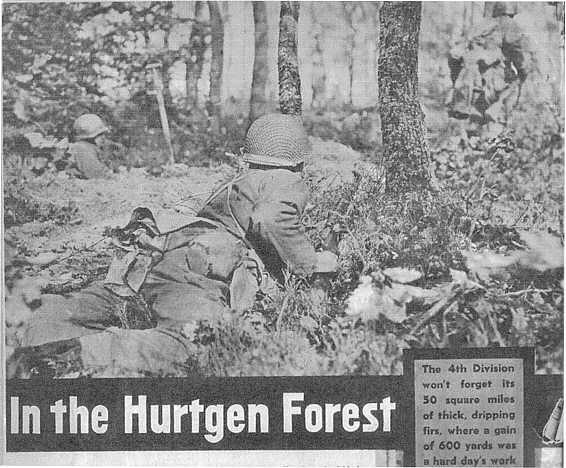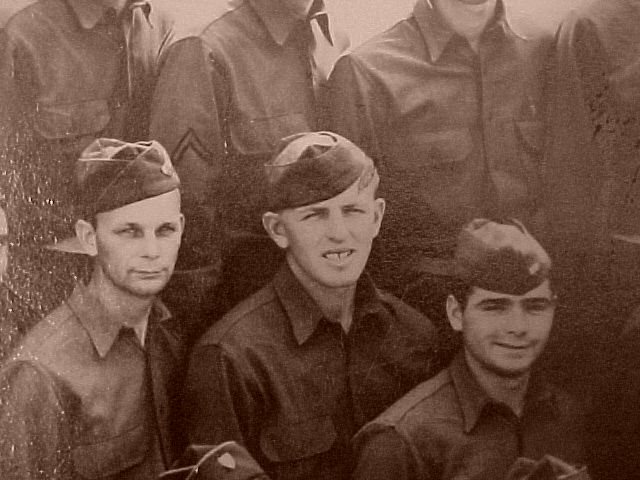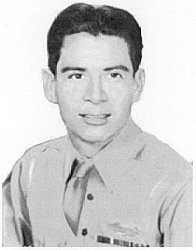![]() 1st Battalion 22nd Infantry
1st Battalion 22nd Infantry ![]()
Battle in the Hurtgen - Stanley Jozwiak

**********************
The following story
concerning Stanley T. Jozwiak was submitted by his son, Kevin
Jozwiak.
Stanley served in 1st Battalion 22nd Infantry, Company B.
A little about my Dad that I have learned through research. Some of this information I have had on record from some help from Mr. G.A Peterson of Cinnamison NJ.
ORDERS Of AWARD OF PURPLE HEART OAK LEAF CLUSTER TO Stanley T. Jozwiak T/Sgt Co "B" 22nd Inf. Regt. Germany 18 April 1945 - By Order of Col. Ward

Stanley Jozwiak
**********************
BATTLE OF HURTGEN FOREST
B CO., 22d Regt., 4th DIV. 16 Nov. - 3 Dec., 1944
{"On 16 Nov, B Co. started to move forward at 1245, and passed through the 3d Bn. Little opposition was encountered, except from artillery and mortar fire, and the move was carried out in column of platoons, squad column. Nine casualities were suffered the first day from artillery fire and mortar fire.
On 17 November B Company had its first major engagement, in a wooded area and hilly terrain, where the enemy had erected hasty defenses and some strong points reinforced by layers of logs and communication trenches. The first strong point was close to crossed firebreaks at (009379). The enemy had sown mines thickly along the firebreak, and defended the firebreak with a pair of machine guns on each side. The left (northwest) side. Visibility was limited to 20 yards, but the enemy apparently had better observation from high ground. This enabled the enemy to zero in on possible approaches.
Four tanks accompanied the advance of B Co. on 17 November. The tanks jumped off the line with the infantry, but quickly spread out along the fire break until there was about 25-30 yards between tanks. The company advanced with three platoons on line, covering 200 yards to the right (southeast) and 100 yards to the left of the firebreak. The 1st, 2d and 3d platoons were arranged in that order from left to right, with the second being closest to the firebreak. Initially, the 2d and 3d had started out abreast, but the 1st platoon was committed on the company's left flank in an attempt to push forward more rapidly.
The tanks had advanced scarcely more than 50 yards before the lead tank hit a group of mines in the firebreak at (009379). There had been no attempt to clear the mines in advance of the tanks. Shortly thereafter a second tank hit a mine, causing two causalities from concussion in the crew. The tank commander attempted to bypass the knocked out tanks, but they blocked the firebreak. Then the tank commander put the other two General Stuarts on line, about 100 yards apart on the left side of the firebreak. Their machine guns sprayed the underbrush, and a few rounds of 37 were fired from a stationary position, and no further advance was made. The tanks were initially effective as a morale factor, but did not materially assist the advance.
About fifty yards beyond where the tanks were knocked out, a machine gun on the left of the firebreak opened up, followed by two on the right of the road. Pfc. Marcario Garcia and Pfc. Charles Jefferies, the lead scouts of the 2d platoon, went out with their BAR's, 30-40 yards in advance of the rest of the platoon and about the same distance from each other. Sucessfully, the three of the machine gun positions were reduced by one of these scouts opening fire to draw fire, the second working around to the flank of the gun and firing, and then an assault squad of about fifeteen men assaulting the gun with a steady rush and maintenance of fire superiority.
[" Garcia and Jefferies were two of the best scouts I have ever seen," said Lt. Bizzaro. " They had just plain guts, and they were always well forward."] Regarding Jefferies, Pfc Ward relates that throughout the campaign, he would never stay in his hole during even the heaviest artillery or mortar barrage, but would be constantly hopping around and firing at possible targets. " I wanna make them think there's a battalion here," Jefferies would always say.
On 17 November, the light machine guns were employed right on the line with assaulting elements. The heavy machine guns were used for only defensive purposes and were not set up for firing until after the after the company had dug in for the night. 18 casualities were suffered on the second day of the attack.
For the next few days, B Company was not very actively engaged. On the 18th, after A and C Co had attacked, B Co. moved up and tied in with the other companies to form an all-around defense. On 19 November, B Co remained in the same position; considerable difficulty was encountered hand-carrying supplies up the hill.
On 20 November, B Co remained in position until noon, when they went to tie in with A Co's right flank, as A and C Cos pushed ahead for 600 yards. After remaining on 21 November, B Co. moved a mile on 22 November to the right flank of the 2n Bn to assist them in securing a vital road junction they had just obtained in that area. On the evening of Thanksgiving Day, according to the company journal, a radio message came announcing that turkey was awaiting the company. ["Believing this to be a code word for something else, a small detail was sent out to find out the score;" the turkey could not be consumed that night because the company underwent another heavy artillery barrage, but the following day it was made available.
On 24 November, B Co rejoined the 1st Bn, on 25 November 3d moved up to the old 3d Bn positions 800 yards ahead (with two casualties) and on 26 November received five casualties from shellfire when C Co attacked to secure the patch of woods west of Grosshau. |
Jeep of the 22nd Infantry in Grosshau, Germany 1944 |
On 27 November, B Co. had a bitter fight to recapture the woods which C Co. had lost the previous day. The platoon started off at 0900, the 17 men in the 1st platoon started off in an irregular skirmish line, crouching in the three-foot grass to to avoid detection. They moved without detection to 30 yards from the edge of the woods, then started firing. Lt. Murray was in the lead, urging his men onward, but a hail of artillery, mortar and small arms fire greeted the platoon as soon as they opened fire. For two hours the platoon tried to advance and succeeded only in crawling up 5-6 yards closer. Lt. Murray was still in the lead, but fortunate enough to have refuge of a large shell crater. The rest of the platoon behind him was annihilated; all 17 were either killed or wounded.
The company then reorganzed, and the 3d platoon prepared to advance toward the same ground, around the right flank of the 1st platoon. The platoon got about 20 yards from the edge of the woods and then recieved the same artillery and shell fire which the 1st platoon had received. The platoon was pulled back, and there were 12-13 men left. The 2d platoon, not yet committed, had 18 men left, and the company once again reorganized in preparation for pressing the attack with the thirty men it had remaining. 4.2 mortar was called for, and it raked the field west of the woods.
The 2d platoon then tried to slip across the field a squad at a time in skirmish line. Ten men got up as far as 20 yards from the woods, when a machine gun had them helplessly pinned down. Pfc Charles Edwards was the first man who endeavored to knock out the gun. Edwards, a former member of the 4th Engineering Battalion, had asked repeatedly to join the company; his wish had finally been granted when the company was in its hottest action around Brandesheid in assaulting the Seigfried Line. Edwards crept up toward the gun, but had not advanced more than five yrds before a quick burst killed him. S/Sgt. Thomas F. Dyess tried to worm his way around through the woods to flank the gun from the right, but he too was wounded in the attempt. Pfc. Macario Garcia, acting squad leader in the support platoon, then went into the woods. Lt. Bizzaro heard several grenades explode, and saw Garcia's form advancing into the edge of the woods. In a few minutes several reports from an M1 rifle were heard. Then Garcia emerged from the woods, saying: ["God damn, I killed three Germans and knocked out that machine gun."] No sooner than he said this when another machine gun opened from another section of the woods and Garcia, though wounded, re-entered the woods, completly annihilated the machine gun crew of three and took four prisoners without assistance. This enabled the rest of the company to advance into the woods."}

Macario Garcia
Staff Sergeant Macario Garcia's Medal of Honor Citation Reads:
Staff Sergeant Macario Garcia, Company B, 22nd Infantry, in action involving actual conflict with the enemy in the vicinity of Grosshau, Germany, 27 November 1944. While an acting squad leader, he single-handedly assaulted two enemy machine gun emplacements. Attacking prepared positions on a wooded hill, which could be approached only through meager cover. His company was pinned down by intense machine-gun fire and subjected to a concentrated artillery and mortar barrage. Although painfully wounded, he refused to be evacuated and on his own initiative crawled forward alone until he reached a position near an enemy emplacement. Hurling grenades, he boldly assaulted the position, destroyed the gun, and with his rifle killed three of the enemy who attempted to escape. When he rejoined his company, a second machine-gun opened fire and again the intrepid soldier went forward, utterly disregarding his own saftey. He stormed the position and destroyed the gun, killed three more Germans, and captured four prisoners. He fought on with his unit until the objective was taken and only then did he permit himself to be removed for medical care. S/Sgt. (then Pvt.) Garcia's conspicuous heroism, his inspiring, courageous conduct, and his complete disregard for his personal saftey wiped out two enemy emplacements and enabled his company to advance and secure its objective.
This is an amazing story no matter how many times I read it. It does me proud that my dad was there also and in an enlisted supervisory role where he could attest to this Heroism. The above accounts were verified with the following MEN:
Lt. Tony Bizzaro, plat ldr., 2d plat., later CO
Lt. William Murray, plat ldr of 1st plat. after 25 Nov.
Lt. Voyage Ramey, forward observer of 44th Field Arty Bn., with B
Co.
Lt. Robert Wessmen, company executive officer
S/Sgt. Joe Forrestor, plat guide of 2d plat; later pl sgt., 1st
pl.
S/Sgt Stanley T. Jozwiak, squad ldr and later plat sgt., 3d plat
Sgt. Christopher C. Neal, sq. ldr and later pl. sgt., wpns plat.
Pfc. Thomas P. Ward, bazookaman and later sq. ldr., 2d plat
Pvt. Alton Byerly, radio operator in Co. hq.
Capt. James McLane, Co B Co., (later 1t Bn. S-3)
The excerpts were declassified on April 1, 1986. I was already a Master Sergeant, in the USAF.
My dad wrote a poem while in a hospital in England recovering from a serious wound inflicted on 14 June 1944, in France. He caught a sniper round in his top left shoulder of his back, the bullet was removed at his lower right back just above his hip. Amazing that he fought again until wounded once more in Germany. The Poem follows, I assume it was published in "The Oyster Bay N.Y." newspaper.
"FOURTH DIVISION MOTHERS
Fourth Division mothers
lift your hands in pride,
While I attempt to tell the story
Of your gallant sons who died.
They stormed those famous beaches
In the June of '44
And thousands of those there with us that day
Aren't with us anymore.
The Cherbourg port was intact
The War Department said
So we paved the road to history with Fourth Division dead.
The Panzers came to meet us
In the daily counter-attacks,
With a blistering concentration
We proudly drove them back.
We broke their line in Normandy
And astounded half the nation,
By blitzing through to Paris
To perform the liberation
The depleted German Army
We threw to quite a loss,
They came to respect our division
The men of the terrible green cross.
We drove them back thru the Ardennes forest
And ripped a hole in the Seigfried Line,
Although we drew out to consolidate
Before heading for the Rhine.
And again we drove into Germany
Determined not to stop,
And that is where you will find us now,
Fighting around the clock.
Mothers of the Fourth Division
Your sons will march with us again
When we parade down Unter Der Linden
And Old Glory Flies over Berlin.
My father spent some time at Lovel General Hospital, Devens Mass, convalescing from wounds incurred and frostbite to his feet. He was there quite a while and from all that any family members remember is that it took quite some time for him to come around. Apparently he also had some very emotional battle scarring. I remember from an Uncle who is now too old to remember, telling me that he actually had to go to Mass and literally force him out of the bed and make him walk. My dad did not discuss the war very much with us. A little here and a little there, was all we got. After so many years and some little research that I have done on some of those battles, I think I can understand. Also as Tom Brokaw put it, "The Greatest Generation"!
Kevin J. Jozwiak
Home | Photos | Battles & History | Current |
Rosters & Reports | Medal of Honor | Killed
in Action |
Personnel Locator | Commanders | Station
List | Campaigns |
Honors | Insignia & Memorabilia | 4-42
Artillery | Taps |
What's New | Editorial | Links |